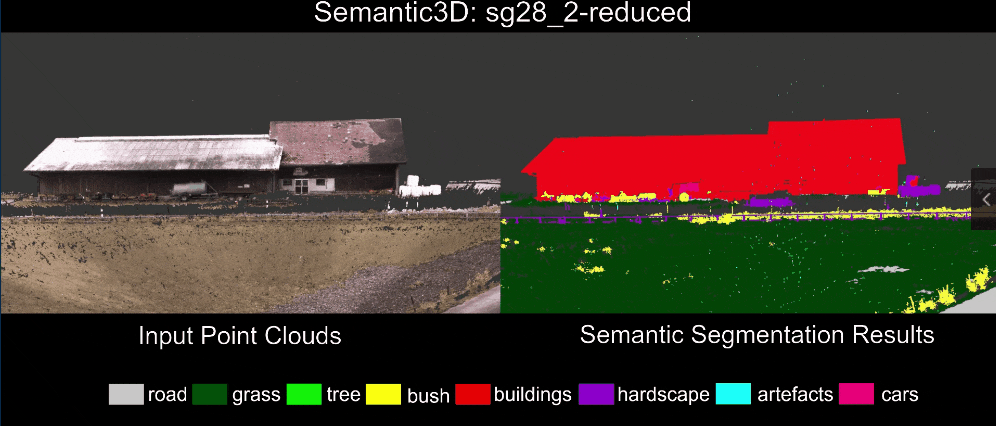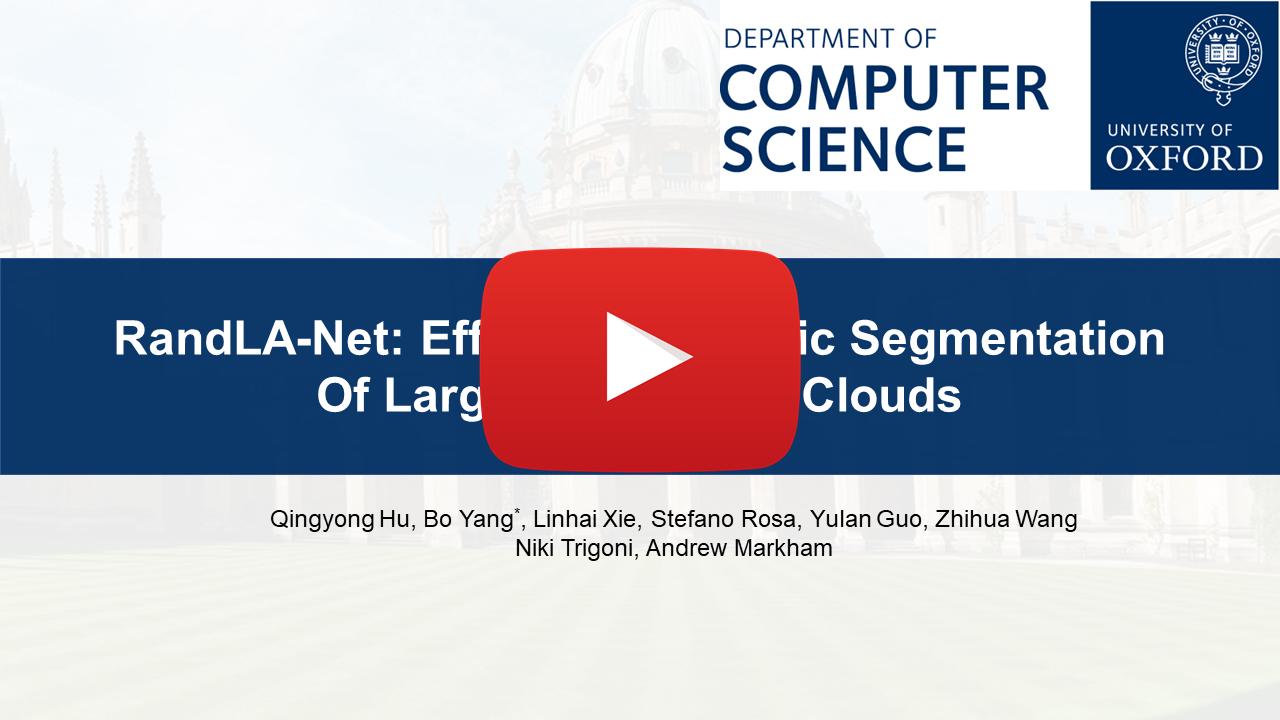Sorry for trouble you.
When I try vis mode,
labels = flat_inputs[21] //main_SemanticKITTI.py line 238 caused a problem, I find the flat_inputs only contains 0-19 items.
When I try test mode, and caused the following problems:
/home/kid/anaconda3/envs/rlnet/bin/python /home/kid/workspace/RandLA-Net/main_SemanticKITTI.py --gpu 0 --mode test --test_area 14
/home/kid/anaconda3/envs/rlnet/lib/python3.5/site-packages/tensorflow/python/framework/dtypes.py:523: FutureWarning: Passing (type, 1) or '1type' as a synonym of type is deprecated; in a future version of numpy, it will be understood as (type, (1,)) / '(1,)type'.
_np_qint8 = np.dtype([("qint8", np.int8, 1)])
/home/kid/anaconda3/envs/rlnet/lib/python3.5/site-packages/tensorflow/python/framework/dtypes.py:524: FutureWarning: Passing (type, 1) or '1type' as a synonym of type is deprecated; in a future version of numpy, it will be understood as (type, (1,)) / '(1,)type'.
_np_quint8 = np.dtype([("quint8", np.uint8, 1)])
/home/kid/anaconda3/envs/rlnet/lib/python3.5/site-packages/tensorflow/python/framework/dtypes.py:525: FutureWarning: Passing (type, 1) or '1type' as a synonym of type is deprecated; in a future version of numpy, it will be understood as (type, (1,)) / '(1,)type'.
_np_qint16 = np.dtype([("qint16", np.int16, 1)])
/home/kid/anaconda3/envs/rlnet/lib/python3.5/site-packages/tensorflow/python/framework/dtypes.py:526: FutureWarning: Passing (type, 1) or '1type' as a synonym of type is deprecated; in a future version of numpy, it will be understood as (type, (1,)) / '(1,)type'.
_np_quint16 = np.dtype([("quint16", np.uint16, 1)])
/home/kid/anaconda3/envs/rlnet/lib/python3.5/site-packages/tensorflow/python/framework/dtypes.py:527: FutureWarning: Passing (type, 1) or '1type' as a synonym of type is deprecated; in a future version of numpy, it will be understood as (type, (1,)) / '(1,)type'.
_np_qint32 = np.dtype([("qint32", np.int32, 1)])
/home/kid/anaconda3/envs/rlnet/lib/python3.5/site-packages/tensorflow/python/framework/dtypes.py:532: FutureWarning: Passing (type, 1) or '1type' as a synonym of type is deprecated; in a future version of numpy, it will be understood as (type, (1,)) / '(1,)type'.
np_resource = np.dtype([("resource", np.ubyte, 1)])
Initiating input pipelines
WARNING:tensorflow:From /home/kid/workspace/RandLA-Net/RandLANet.py:265: softmax_cross_entropy_with_logits (from tensorflow.python.ops.nn_ops) is deprecated and will be removed in a future version.
Instructions for updating:
Future major versions of TensorFlow will allow gradients to flow
into the labels input on backprop by default.
See tf.nn.softmax_cross_entropy_with_logits_v2.
/home/kid/anaconda3/envs/rlnet/lib/python3.5/site-packages/tensorflow/python/ops/gradients_impl.py:108: UserWarning: Converting sparse IndexedSlices to a dense Tensor of unknown shape. This may consume a large amount of memory.
"Converting sparse IndexedSlices to a dense Tensor of unknown shape. "
Model restored from results/SemanticKITTI/snapshots/snap-277357
step 0
Traceback (most recent call last):
File "/home/kid/anaconda3/envs/rlnet/lib/python3.5/site-packages/tensorflow/python/client/session.py", line 1292, in _do_call
return fn(*args)
File "/home/kid/anaconda3/envs/rlnet/lib/python3.5/site-packages/tensorflow/python/client/session.py", line 1277, in _run_fn
options, feed_dict, fetch_list, target_list, run_metadata)
File "/home/kid/anaconda3/envs/rlnet/lib/python3.5/site-packages/tensorflow/python/client/session.py", line 1367, in _call_tf_sessionrun
run_metadata)
tensorflow.python.framework.errors_impl.ResourceExhaustedError: OOM when allocating tensor with shape[901120,16,16] and type float on /job:localhost/replica:0/task:0/device:GPU:0 by allocator GPU_0_bfc
[[{{node layers/Softmax}} = SoftmaxT=DT_FLOAT, _device="/job:localhost/replica:0/task:0/device:GPU:0"]]
Hint: If you want to see a list of allocated tensors when OOM happens, add report_tensor_allocations_upon_oom to RunOptions for current allocation info.
[[{{node layers/Encoder_layer_2LFAatt_pooling_1fc/Tensordot/Shape/_929}} = _Recv[client_terminated=false, recv_device="/job:localhost/replica:0/task:0/device:CPU:0", send_device="/job:localhost/replica:0/task:0/device:GPU:0", send_device_incarnation=1, tensor_name="edge_1963_layers/Encoder_layer_2LFAatt_pooling_1fc/Tensordot/Shape", tensor_type=DT_INT32, _device="/job:localhost/replica:0/task:0/device:CPU:0"]()]]
Hint: If you want to see a list of allocated tensors when OOM happens, add report_tensor_allocations_upon_oom to RunOptions for current allocation info.
During handling of the above exception, another exception occurred:
Traceback (most recent call last):
File "/home/kid/workspace/RandLA-Net/main_SemanticKITTI.py", line 226, in
tester.test(model, dataset)
File "/home/kid/workspace/RandLA-Net/tester_SemanticKITTI.py", line 78, in test
stacked_probs, labels, point_inds, cloud_inds = self.sess.run(ops, {model.is_training: False})
File "/home/kid/anaconda3/envs/rlnet/lib/python3.5/site-packages/tensorflow/python/client/session.py", line 887, in run
run_metadata_ptr)
File "/home/kid/anaconda3/envs/rlnet/lib/python3.5/site-packages/tensorflow/python/client/session.py", line 1110, in _run
feed_dict_tensor, options, run_metadata)
File "/home/kid/anaconda3/envs/rlnet/lib/python3.5/site-packages/tensorflow/python/client/session.py", line 1286, in _do_run
run_metadata)
File "/home/kid/anaconda3/envs/rlnet/lib/python3.5/site-packages/tensorflow/python/client/session.py", line 1308, in _do_call
raise type(e)(node_def, op, message)
tensorflow.python.framework.errors_impl.ResourceExhaustedError: OOM when allocating tensor with shape[901120,16,16] and type float on /job:localhost/replica:0/task:0/device:GPU:0 by allocator GPU_0_bfc
[[{{node layers/Softmax}} = SoftmaxT=DT_FLOAT, _device="/job:localhost/replica:0/task:0/device:GPU:0"]]
Hint: If you want to see a list of allocated tensors when OOM happens, add report_tensor_allocations_upon_oom to RunOptions for current allocation info.
[[{{node layers/Encoder_layer_2LFAatt_pooling_1fc/Tensordot/Shape/_929}} = _Recv[client_terminated=false, recv_device="/job:localhost/replica:0/task:0/device:CPU:0", send_device="/job:localhost/replica:0/task:0/device:GPU:0", send_device_incarnation=1, tensor_name="edge_1963_layers/Encoder_layer_2LFAatt_pooling_1fc/Tensordot/Shape", tensor_type=DT_INT32, _device="/job:localhost/replica:0/task:0/device:CPU:0"]()]]
Hint: If you want to see a list of allocated tensors when OOM happens, add report_tensor_allocations_upon_oom to RunOptions for current allocation info.
Caused by op 'layers/Softmax', defined at:
File "/home/kid/workspace/RandLA-Net/main_SemanticKITTI.py", line 213, in
model = Network(dataset, cfg)
File "/home/kid/workspace/RandLA-Net/RandLANet.py", line 52, in init
self.logits = self.inference(self.inputs, self.is_training)
File "/home/kid/workspace/RandLA-Net/RandLANet.py", line 115, in inference
'Encoder_layer_' + str(i), is_training)
File "/home/kid/workspace/RandLA-Net/RandLANet.py", line 272, in dilated_res_block
f_pc = self.building_block(xyz, f_pc, neigh_idx, d_out, name + 'LFA', is_training)
File "/home/kid/workspace/RandLA-Net/RandLANet.py", line 285, in building_block
f_pc_agg = self.att_pooling(f_concat, d_out // 2, name + 'att_pooling_1', is_training)
File "/home/kid/workspace/RandLA-Net/RandLANet.py", line 352, in att_pooling
att_scores = tf.nn.softmax(att_activation, axis=1)
File "/home/kid/anaconda3/envs/rlnet/lib/python3.5/site-packages/tensorflow/python/util/deprecation.py", line 488, in new_func
return func(*args, **kwargs)
File "/home/kid/anaconda3/envs/rlnet/lib/python3.5/site-packages/tensorflow/python/ops/nn_ops.py", line 1746, in softmax
return _softmax(logits, gen_nn_ops.softmax, axis, name)
File "/home/kid/anaconda3/envs/rlnet/lib/python3.5/site-packages/tensorflow/python/ops/nn_ops.py", line 1707, in _softmax
output = compute_op(logits)
File "/home/kid/anaconda3/envs/rlnet/lib/python3.5/site-packages/tensorflow/python/ops/gen_nn_ops.py", line 7138, in softmax
"Softmax", logits=logits, name=name)
File "/home/kid/anaconda3/envs/rlnet/lib/python3.5/site-packages/tensorflow/python/framework/op_def_library.py", line 787, in _apply_op_helper
op_def=op_def)
File "/home/kid/anaconda3/envs/rlnet/lib/python3.5/site-packages/tensorflow/python/util/deprecation.py", line 488, in new_func
return func(*args, **kwargs)
File "/home/kid/anaconda3/envs/rlnet/lib/python3.5/site-packages/tensorflow/python/framework/ops.py", line 3272, in create_op
op_def=op_def)
File "/home/kid/anaconda3/envs/rlnet/lib/python3.5/site-packages/tensorflow/python/framework/ops.py", line 1768, in init
self._traceback = tf_stack.extract_stack()
ResourceExhaustedError (see above for traceback): OOM when allocating tensor with shape[901120,16,16] and type float on /job:localhost/replica:0/task:0/device:GPU:0 by allocator GPU_0_bfc
[[{{node layers/Softmax}} = SoftmaxT=DT_FLOAT, _device="/job:localhost/replica:0/task:0/device:GPU:0"]]
Hint: If you want to see a list of allocated tensors when OOM happens, add report_tensor_allocations_upon_oom to RunOptions for current allocation info.
[[{{node layers/Encoder_layer_2LFAatt_pooling_1fc/Tensordot/Shape/_929}} = _Recv[client_terminated=false, recv_device="/job:localhost/replica:0/task:0/device:CPU:0", send_device="/job:localhost/replica:0/task:0/device:GPU:0", send_device_incarnation=1, tensor_name="edge_1963_layers/Encoder_layer_2LFAatt_pooling_1fc/Tensordot/Shape", tensor_type=DT_INT32, _device="/job:localhost/replica:0/task:0/device:CPU:0"]()]]
Hint: If you want to see a list of allocated tensors when OOM happens, add report_tensor_allocations_upon_oom to RunOptions for current allocation info.
Process finished with exit code 1



















